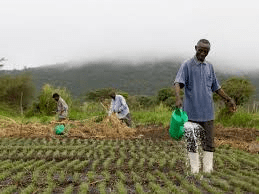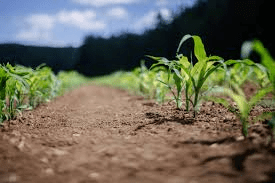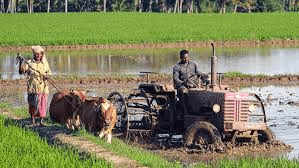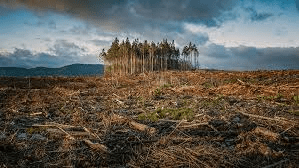Agriculture is essential for feeding the world’s population, but it also has a significant impact on the environment. As we work to grow food, raise animals, and cultivate crops, we change the natural landscape, use resources, and sometimes cause harm to the environment.
Understanding these impacts is important for finding ways to reduce the negative effects and create more sustainable agricultural practices. This article will guide you through the key factors of agricultural environmental impact, how agriculture shapes our environment, and the challenges and solutions associated with these impacts.
Understanding the Environmental Impact of Modern Agriculture
Modern agriculture has revolutionized food production, allowing us to feed billions of people. However, it also brings challenges to the environment. The environmental impact of modern agriculture includes the depletion of natural resources, pollution, loss of biodiversity, and climate change.
Depletion of Natural Resources
Modern agriculture relies heavily on natural resources such as water, soil, and fossil fuels. Irrigation uses vast amounts of water, often depleting local water supplies and affecting ecosystems. Overuse of soil can lead to degradation, making it less fertile over time. Fossil fuels are used in machinery, transportation, and the production of fertilizers and pesticides, contributing to greenhouse gas emissions.
Pollution
Agricultural activities can lead to various forms of pollution. The use of chemical fertilizers and pesticides can contaminate soil and water bodies, harming wildlife and even entering the human food chain. Animal waste from large-scale farming operations can also pollute water sources, leading to problems like algae blooms and dead zones in water bodies where life cannot survive.
Loss of Biodiversity
The expansion of agricultural land often leads to deforestation and the destruction of natural habitats, resulting in a loss of biodiversity. When forests and other natural areas are converted into farmland, many plant and animal species lose their homes and may become endangered or extinct. Monoculture farming, where a single crop is grown over large areas, further reduces biodiversity by limiting the variety of plants and animals that can thrive in those areas.
Climate Change
Agriculture is both affected by and contributes to climate change. Farming activities release greenhouse gases such as carbon dioxide, methane, and nitrous oxide into the atmosphere. These gases trap heat and lead to global warming. Livestock farming, particularly cattle, is a major source of methane emissions. Additionally, deforestation for agriculture reduces the number of trees that can absorb carbon dioxide, further exacerbating climate change.
Read Also: The Health Benefits of Using Maggi Masala on your Cooking
Key Factors of Agricultural Environmental Impact: What You Need to Know

Several key factors contribute to the environmental impact of agriculture. Understanding these factors can help us identify areas where improvements can be made to reduce negative effects and promote sustainability.
Land Use
The way land is used for agriculture has a significant impact on the environment. Deforestation, habitat destruction, and soil degradation are major concerns. Sustainable land management practices, such as crop rotation, agroforestry, and conservation tillage, can help minimize these impacts.
Water Use
Agriculture is the largest consumer of fresh water globally. Efficient water management practices, such as drip irrigation and rainwater harvesting, can reduce water waste and help preserve water resources. Protecting water quality by minimizing the use of harmful chemicals is also crucial.
Soil Health
Healthy soil is essential for productive agriculture, but intensive farming practices can degrade soil quality. Practices such as overgrazing, improper crop rotation, and excessive use of fertilizers and pesticides can lead to soil erosion, loss of nutrients, and reduced fertility. Promoting soil health through practices like composting, cover cropping, and reduced tillage can help maintain soil productivity and prevent erosion.
Chemical Use
The use of synthetic fertilizers, pesticides, and herbicides in agriculture can lead to environmental pollution and harm to human health. These chemicals can leach into water sources, contaminate soil, and harm non-target species, including beneficial insects like bees. Reducing chemical use through integrated pest management, organic farming, and the use of natural fertilizers can mitigate these impacts.
Greenhouse Gas Emissions
Agriculture contributes to greenhouse gas emissions through the use of fossil fuels, livestock production, and deforestation. Practices such as reducing tillage, planting cover crops, and improving livestock management can help reduce emissions.
Additionally, carbon sequestration techniques, such as planting trees and restoring wetlands, can capture and store carbon, offsetting some of the emissions from agriculture.
Read Also: 16 Medicinal Health Benefits Of Piper excelsum (Kawakawa)
How Agriculture Shapes Our Environment: A Clear Look at the Impact

Agriculture has a profound impact on the environment, shaping landscapes, ecosystems, and even the climate. By understanding how agriculture influences the environment, we can make informed decisions to reduce its negative effects.
Landscape Changes
Agriculture alters the natural landscape in several ways. Forests are cleared for cropland and pasture, wetlands are drained for cultivation, and grasslands are converted into farmland. These changes can lead to habitat loss, soil erosion, and changes in local climate conditions. For example, deforestation can reduce rainfall in an area, leading to drier conditions and making it harder to grow crops.
Soil Erosion and Degradation
Intensive farming practices, such as plowing and monoculture, can lead to soil erosion, where the topsoil is worn away by wind and water. This topsoil is the most fertile layer, rich in nutrients necessary for plant growth. Without it, crops struggle to grow, leading to reduced yields and the need for more chemical fertilizers. Soil degradation also reduces the soil’s ability to retain water, making it more susceptible to drought.
Water Pollution
Agriculture is a major source of water pollution. Runoff from fields can carry fertilizers, pesticides, and animal waste into rivers, lakes, and oceans. This can lead to water contamination, harming aquatic life and making water unsafe for human consumption. Nutrient runoff from fertilizers can also cause algal blooms, which deplete oxygen levels in the water and create dead zones where aquatic life cannot survive.
Impact on Wildlife
Agriculture affects wildlife in various ways. Habitat loss due to land conversion forces animals to relocate, often to less suitable environments. Pesticides can harm non-target species, including birds, insects, and aquatic life. In some cases, wildlife may come into conflict with farmers, leading to further threats to their survival. Conservation efforts and wildlife-friendly farming practices can help mitigate these impacts.
Contribution to Climate Change
As mentioned earlier, agriculture contributes to climate change through greenhouse gas emissions. This not only exacerbates global warming but also affects agricultural productivity. Changes in temperature and rainfall patterns can lead to crop failures, reduced yields, and increased pest and disease outbreaks. Sustainable farming practices, such as agroecology and regenerative agriculture, can help reduce agriculture’s contribution to climate change.
Environmental Consequences of Agricultural Practices: A Simple Guide
Understanding the environmental consequences of agricultural practices is essential for developing more sustainable farming methods. Here are some common practices and their impacts:
Monoculture Farming
Monoculture involves growing a single crop over a large area. While it can be efficient, it also has several downsides. Monoculture depletes the soil of specific nutrients, leading to the need for chemical fertilizers. It also increases the risk of pests and diseases, as large populations of a single crop provide an easy target for these threats. Crop rotation and polyculture (growing multiple crops together) can help reduce these risks.
Overgrazing
Overgrazing occurs when livestock eat grass faster than it can regrow, leading to soil erosion and degradation. This practice can turn fertile land into barren desert, reducing its ability to support life. Rotational grazing, where livestock are moved between different pastures, can prevent overgrazing and help maintain healthy grasslands.
Excessive Irrigation
Irrigation is necessary in many regions, but excessive use can lead to problems such as waterlogging, salinization, and depletion of water resources. Waterlogging occurs when too much water is applied, suffocating plant roots and leading to poor crop yields. Salinization happens when irrigation water evaporates, leaving salts behind in the soil, which can be toxic to plants. Efficient irrigation methods, such as drip irrigation, can reduce water use and prevent these issues.
Deforestation
Clearing forests for agriculture leads to loss of biodiversity, disruption of ecosystems, and increased greenhouse gas emissions. Forests act as carbon sinks, absorbing carbon dioxide from the atmosphere. When they are cut down, this carbon is released, contributing to climate change. Reforestation and agroforestry (integrating trees into farming systems) are ways to mitigate the impacts of deforestation.
Use of Chemical Fertilizers and Pesticides
While chemical fertilizers and pesticides can increase crop yields, they also have negative environmental effects. Overuse can lead to soil and water contamination, harm beneficial insects, and contribute to the development of pesticide-resistant pests. Organic farming and integrated pest management (IPM) practices can reduce the reliance on synthetic chemicals and promote a healthier environment.
Agricultural Environmental Impact: Challenges and Solutions Explained

Agriculture faces several challenges when it comes to minimizing its environmental impact. However, there are also solutions that can help make farming more sustainable.
Challenge: Resource Depletion
Agriculture requires large amounts of water, soil, and energy, which can lead to resource depletion. As these resources become scarcer, it becomes more challenging to maintain agricultural productivity.
Solution: Sustainable Resource Management
Implementing practices such as efficient irrigation, soil conservation, and renewable energy use can help conserve resources. For example, farmers can use drip irrigation to reduce water waste, practice crop rotation to maintain soil fertility, and adopt solar-powered equipment to reduce fossil fuel use.
Challenge: Pollution
Agricultural activities can pollute soil, water, and air, leading to negative health and environmental effects.
Solution: Reducing Chemical Use
Reducing the use of synthetic chemicals through organic farming, integrated pest management, and the use of natural fertilizers
can minimize pollution. Farmers can also implement buffer zones, such as planting trees or grasses around fields, to reduce runoff and protect water sources.
Challenge: Climate Change
Agriculture contributes to climate change, which in turn affects agricultural productivity.
Solution: Climate-Smart Agriculture
Climate-smart agriculture involves practices that reduce greenhouse gas emissions and increase resilience to climate change. This can include using cover crops, reducing tillage, and improving livestock management. Additionally, carbon sequestration techniques, such as agroforestry and soil carbon storage, can help offset emissions from agriculture.
Challenge: Biodiversity Loss
The expansion of agriculture often leads to habitat destruction and loss of biodiversity.
Solution: Promoting Biodiversity
Farmers can promote biodiversity by adopting practices such as polyculture, agroforestry, and maintaining natural habitats on their land. These practices not only support wildlife but can also improve crop yields and resilience to pests and diseases.
Challenge: Soil Degradation
Intensive farming practices can lead to soil erosion, loss of nutrients, and reduced fertility.
Solution: Soil Health Management
Promoting soil health through practices like composting, cover cropping, and reduced tillage can help maintain soil productivity and prevent erosion. Healthy soil supports healthy crops, leading to better yields and reduced need for chemical inputs.
Conclusion
Agriculture is vital for human survival, but it also has significant environmental impacts. Understanding these impacts is the first step toward creating more sustainable agricultural practices. By addressing challenges such as resource depletion, pollution, climate change, and biodiversity loss, we can develop solutions that protect the environment while ensuring food security for future generations. Sustainable farming practices, such as efficient resource management, reducing chemical use, and promoting biodiversity, offer a way forward in balancing agricultural productivity with environmental stewardship.
Read Also: How to Graft an Avocado Tree to Produce Avocado Fruit

